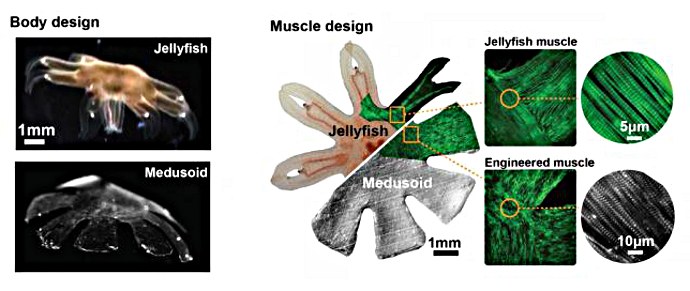
The top shows a comparison of real jellyfish and silicone-based Medusoid. The bottom is a comparison of muscle architecture in the two systems. Photo by Caltech / Janna Nawroth.
“The world needs less rats and more jellyfish, so I thought it would be cool to do a one-for-one swap,” mused Kevin Kit Parker, Tarr Family Professor of Bioengineering and Applied Physics at Harvard, to Live Science yesterday.
In all seriousness, what Parker’s group created is a bioeengineered jellyfish medusa from a thin sheet of silicone and rat heart tissue. When the eight “pronged” apparatus is placed into an electrically conductive fluid in a container and an electric field is applied, it contracts like a real jellyfish medusa.
“A big goal of our study was to advance tissue engineering,” says Janna Nawroth, a doctoral student in biology at Caltech. “In many ways, it is still a very qualitative art, with people trying to copy a tissue or organ just based on what they think is important or what they see as the major components—without necessarily understanding if those components are relevant to the desired function or without analyzing first how different materials could be used.”
The researchers chose jellyfish as their prime target for their research as on a basic level their pulsing is similar to that of the human heart when it contracts sending blood throughout our bodies.
“It occurred to me in 2007 that we might have failed to understand the fundamental laws of muscular pumps,” says Parker. “I started looking at marine organisms that pump to survive. Then I saw a jellyfish at the New England Aquarium, and I immediately noted both similarities and differences between how the jellyfish pumps and the human heart. The similarities help reveal what you need to do to design a bio-inspired pump.”
“I was surprised that with relatively few components—a silicone base and cells that we arranged—we were able to reproduce some pretty complex swimming and feeding behaviors that you see in biological jellyfish,” comments Dabiri. “I’m pleasantly surprised at how close we are getting to matching the natural biological performance, but also that we’re seeing ways in which we can probably improve on that natural performance. The process of evolution missed a lot of good solutions.”
With the success of their bioengineered jellyfish medusa, their next steps are more ambitious. The group plans to enhance the current prototype with more function — ability to pulse on its own and sense its environment. Long term it is hoped advances made with things as simple as a medusa might eventually translate into advancing biomedical technology.
(via EurekAlert)









0 Comments